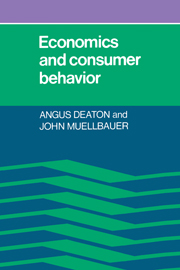Book contents
- Frontmatter
- Contents
- List of tables and figures
- Preface
- PART ONE CONSUMER DEMAND ANALYSIS
- 1 The limits to choice
- 2 Preferences and demand
- 3 The theory at work
- 4 Extensions to the basic model
- PART TWO SEPARABILITY AND AGGREGATION
- PART THREE WELFARE AND CONSUMER BEHAVIOR
- PART FOUR EXTENSIONS AND APPLICATIONS
- References
- List of notation
- Name index
- Subject index
3 - The theory at work
Published online by Cambridge University Press: 05 June 2012
- Frontmatter
- Contents
- List of tables and figures
- Preface
- PART ONE CONSUMER DEMAND ANALYSIS
- 1 The limits to choice
- 2 Preferences and demand
- 3 The theory at work
- 4 Extensions to the basic model
- PART TWO SEPARABILITY AND AGGREGATION
- PART THREE WELFARE AND CONSUMER BEHAVIOR
- PART FOUR EXTENSIONS AND APPLICATIONS
- References
- List of notation
- Name index
- Subject index
Summary
The theory presented in Chapter 2 offers a framework within which we can attempt to organize and interpret the data. This chapter begins this task by discussing the application of four particular models, each of which seeks to describe the way in which total outlay is spent. These illustrations not only show how the theory can be made specific but also allow us to check the usefulness of the theory in empirical work. In this context, various problems and difficulties are pointed out as we go along. The identification of them provides much of the motivation for the extensions and modifications of the theory that are begun in the next three chapters.
Although we make no attempt to provide a historical survey of applications of demand theory, the studies will be presented in rough chronological order. This is natural, since there has been a steady growth in the degree to which practical work has based itself upon the theory. In §3.1, we shall discuss some of the methodology and results in Stone's justly famous 1954 monograph, The Measurement of Consumers' Expenditure and Behaviour. This study follows the precedent of virtually all studies up to that time in modeling commodity demands individually, equation by equation, so that, if necessary, the functional form can be varied and special explanatory variables introduced. This approach has the great advantage of flexibility and is undoubtedly the best way of modeling the demand for an individual commodity in isolation.
- Type
- Chapter
- Information
- Economics and Consumer Behavior , pp. 60 - 85Publisher: Cambridge University PressPrint publication year: 1980
- 1
- Cited by



